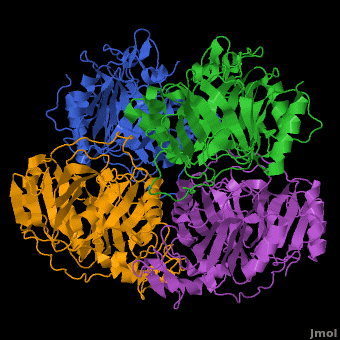Dioxygenase
From Proteopedia
(Difference between revisions)
m (Reverted edits by Michal Harel (Talk); changed back to last version by Alexander Berchansky) |
|||
| Line 1: | Line 1: | ||
| - | <StructureSection size=" | + | <StructureSection size="450" scene ="Journal:JBIC:5/Opening/2" caption="Solved Crystal Structure of Hyperactive Catechol Dioxygenase"> |
'''Dioxygenases''' cleave the aromatic rings of their substrates by inserting two oxygen atoms, thus degrading these compounds. The dioxygenases are divided into 2 groups according to their mode of ring scission. The intradiol enzymes use Fe+3 as cofactor and cleave the substrate between 2 hydroxyl groups. The extradiol enzymes use Fe+2 as cofactor and cleave the substrate between a hydroxylated carbon and a non-hydroxylated one. <br /> | '''Dioxygenases''' cleave the aromatic rings of their substrates by inserting two oxygen atoms, thus degrading these compounds. The dioxygenases are divided into 2 groups according to their mode of ring scission. The intradiol enzymes use Fe+3 as cofactor and cleave the substrate between 2 hydroxyl groups. The extradiol enzymes use Fe+2 as cofactor and cleave the substrate between a hydroxylated carbon and a non-hydroxylated one. <br /> | ||
| Line 6: | Line 6: | ||
* '''Homoprotocatechuate 3,4-dioxygenase''' (HPCD), an extradiol cleaving enzyme cleaves the aromatic ring of its substrate, adds 2 oxygen atoms to form α-hydroxy-δ carboxymethyl muconic semialdehyde.<br /> | * '''Homoprotocatechuate 3,4-dioxygenase''' (HPCD), an extradiol cleaving enzyme cleaves the aromatic ring of its substrate, adds 2 oxygen atoms to form α-hydroxy-δ carboxymethyl muconic semialdehyde.<br /> | ||
* '''Naphthalene 1,2-dioxygenase''' (NDO) catalyzes the conversion of naphthalene and O2 to dihydronaphthalene-diol.<br /> | * '''Naphthalene 1,2-dioxygenase''' (NDO) catalyzes the conversion of naphthalene and O2 to dihydronaphthalene-diol.<br /> | ||
| - | * '''Glyoxalase/bleomycin resistant protein/dioxygenase''' (GBD) catalyzes the cleavage of S-lactoyl-glutathione to methylglyoxal and glutathione | + | * '''Glyoxalase/bleomycin resistant protein/dioxygenase''' (GBD) catalyzes the cleavage of S-lactoyl-glutathione to methylglyoxal and glutathione. |
| - | + | ||
| - | + | ||
=== A Hyperactive Cobalt-Substituted Extradiol-Cleaving Catechol Dioxygenase <ref>DOI 10.1007/s00775-010-0732-0</ref>=== | === A Hyperactive Cobalt-Substituted Extradiol-Cleaving Catechol Dioxygenase <ref>DOI 10.1007/s00775-010-0732-0</ref>=== | ||
| Line 124: | Line 122: | ||
**[[3khc]] – hAlkb (mutant) + Co+2 + oxoglutarate + DNA + inhibitor<br /> | **[[3khc]] – hAlkb (mutant) + Co+2 + oxoglutarate + DNA + inhibitor<br /> | ||
**[[3o1v]], [[3o1u]], [[3o1t]], [[3t1s]] – hAlkb (mutant) + Fe+3 + succinate + DNA + inhibitor<br /> | **[[3o1v]], [[3o1u]], [[3o1t]], [[3t1s]] – hAlkb (mutant) + Fe+3 + succinate + DNA + inhibitor<br /> | ||
| - | |||
| - | *α-ketoglutarate-dependent dioxygenase homolog 5 (Alkbh5) | ||
| - | |||
| - | **[[4nj4]], [[4o7x]] – hAlkbh5 residues 66-292 + Mn<br /> | ||
| - | **[[4o61]] – hAlkbh5 residues 74-294 + citrate<br /> | ||
| - | **[[4nrm]] – hAlkbh5 residues 66-292 + citrate + acetate<br /> | ||
| - | **[[4nro]] – hAlkbh5 residues 66-292 + Mn + ketoglutarate <br /> | ||
| - | **[[4oct]] – hAlkbh5 residues 66-292 + Mn + oxoglutarate <br /> | ||
| - | **[[4nrp]] – hAlkbh5 residues 66-292 + Mn + oxalylglycine <br /> | ||
| - | **[[4nrq]] – hAlkbh5 residues 66-292 + Mn + pyridine dicarboxylate <br /> | ||
| - | **[[4npl]] – zfAlkbh5 residues 38-287 + Mn + ketoglutarate – zebra fish<br /> | ||
| - | **[[4npm]] – zfAlkbh5 residues 38-287 + Mn + succinate <br /> | ||
*Leucoanthocyanidin dioxygenase (LACD) | *Leucoanthocyanidin dioxygenase (LACD) | ||
| Line 141: | Line 127: | ||
**[[1gp5]], [[1gp6]] – AtLACD + dihydroquercetin – ''Arabidopsis thaliana'' <br /> | **[[1gp5]], [[1gp6]] – AtLACD + dihydroquercetin – ''Arabidopsis thaliana'' <br /> | ||
**[[2brt]] – AtLACD + naringenin <br /> | **[[2brt]] – AtLACD + naringenin <br /> | ||
| - | |||
| - | *Ten-eleven translocation methylcytosine dioxygenase (TET) | ||
| - | |||
| - | **[[5deu]] - hTET2 + DNA + deoxyhydroxymethyl cytidine dihydrogen phosphate<br /> | ||
| - | **[[5d9y]] - hTET2 + DNA + formyl deoxy CMP<br /> | ||
| - | **[[4nm6]] - hTET2 + DNA + methyl deoxy CMP<br /> | ||
| - | **[[4z3c]] - hTET3 + DNA<br /> | ||
| - | **[[5exh]] - mTET3 CXXC domain + DNA + carboxy deoxy CMP<br /> | ||
*'''Dioxygenase extradiol family''' | *'''Dioxygenase extradiol family''' | ||
Revision as of 20:07, 14 January 2017
| |||||||||||
3D structures of Protocatechuate 3,4-dioxygenase
Updated on 14-January-2017
- ↑ Fielding AJ, Kovaleva EG, Farquhar ER, Lipscomb JD, Que L Jr. A hyperactive cobalt-substituted extradiol-cleaving catechol dioxygenase. J Biol Inorg Chem. 2010 Dec 14. PMID:21153851 doi:10.1007/s00775-010-0732-0
Proteopedia Page Contributors and Editors (what is this?)
Michal Harel, Alexander Berchansky, Joel L. Sussman, Jaime Prilusky

